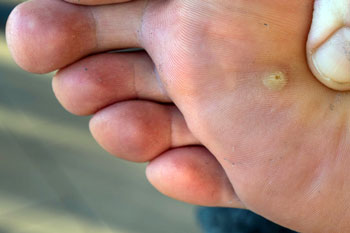
Plantar warts are thickened lesions of skin that develop mainly on the bottom of your foot after contact with the human papillomavirus (HPV). The HPV leads to keratin building up on the skin, resulting in a plantar wart, or a cluster of warts (mosaic).
Symptoms of a Plantar Wart
Plantar warts typically grow on the sole of the foot, however they can develop anywhere on the foot. A plantar wart can:
- Be flat and thickened
- Have a tiny black “dot” in the center of the wart, which is actually a minuscule capillary with dried blood in it.
- Be hard, fleshy, and light or skin-colored
- Be painful when walking
- Spread into a cluster of warts called a mosaic
How Do Plantar Warts Develop?
HPV lives in moist, damp environments such as swimming pool areas, locker room floor, public showers, etc. A person can become infected by the virus through direct contact with it by walking through a puddle or other breeding grounds for HPV.
The virus has easy access to the skin of the feet if the person is walking barefoot. Cracks or weak spots in the skin make it even easier for the virus to enter. That is why it is important to never walk barefoot in these areas—especially those with weakened immune systems, who are at an increased risk of developing a plantar wart.
Treating a Plantar Wart
Plantar warts can be very hearty and difficult to treat at home because even if the wart is gone, the virus may still be lying dormant underneath the skin. It can sometimes take years for a plantar wart to dissolve on its own.
A podiatrist can get rid of plantar warts efficiently, rapidly, safely and completely using a variety of protocols, depending on how far along the wart is and the medical history of the patient.
- Peeling. In some patients, salicylic acid may be used to safely thin down the wart and cause infected skin cells to peel off.
- Freezing. A technique call cryotreatment can be used, which freezes the wart and eventually eliminates it.
- Cutting. The podiatrist may try to scrape the wart off (curetting) or cut it out by excision.
- Laser Therapy. This non-invasive treatment gets to the wart’s blood supply which causes the wart to fall off within a couple of weeks.
If you suspect you have a plantar wart or a mosaic of plantar warts, get treated by a podiatrist for quick and lasting results.
